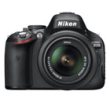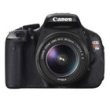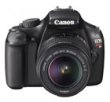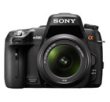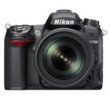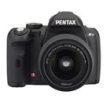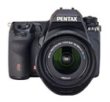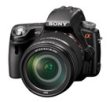HDSLRs: Digital SLRs With Video
Welcome to the brave new world of the HDSLR.
An HDSLR is a digital SLR camera that is also capable of shooting High Definition (HD) video.
The name is a blend, and combines the HD (the video capability) with the SLR (the still image capability). For those who must know the acronym spelled out is: High Definition Single Lens Reflex camera.
If you're not yet well versed in this terminology, you can learn more HDSLR video jargon, or you can find out what SLR stands for.
In the Beginning: Live View
For a long time a standard feature on compact digital cameras - the ability to compose a photo using the LCD screen on the camera's back - didn't exist on any digital SLR.
When using a digital SLR, you had to compose all of your photos by looking through the viewfinder.
But then Olympus had a breakthrough with their E-330: they found a way to change the technology so that you could use either the LCD or viewfinder to compose images. Live view was born.
Today, live view LCDs are quite common on all new digital SLR cameras.
Once the cameras had the ability to display a "live" image on the LCD screen, it was not that much more of a leap to capture that live image as a video clip.
Benefits of SLR Video
One of the nice things about having a digital SLR with video is that it can capture motion and sound when a still image just won't tell the entire story.
I've taken hundreds of photos of my son dancing around the living room to music, and a few of them do capture the essence of his performance.
But there's one thing missing: the music itself.
With an HDSLR, I can grab some still images of him jumping about, and then quickly switch to video mode for full motion and sound.
Clearly, some subjects will benefit more from video capture than others (landscapes don't DO very much).
A second benefit of capturing video with a digital SLR is somewhat less obvious.
Since you are able to change the lens on a digital SLR (something you can't do with a standard video camera) you can capture some VERY interesting shots.
This is especially true when you use specialty lenses: extreme wide angle, extreme telephoto, or macro.
For example, with a macro lens, you're able to get up close and personal with even the smallest subjects. Imagine being able to capture your very own nature documentary (Ants at Work) right in your backyard.
Or, maybe you're really into surfing.
With an extreme telephoto lens attached to the camera (and a really nice tripod) you can capture the action as if you were sitting right in front of the wave.
Limitations of SLR Video
Since digital SLR video technology is in its infancy, it's not without limitations.
If you decide to get a digital SLR with video right now, there are two things that you'll have to deal with (although some cameras are already overcoming these):
- Autofocus can be slow - the high-tech autofocus system in the camera can't be used during video capture
- Movie duration is limited - digital sensors get hot the longer they are used, so time limits are placed on video capture so the sensor doesn't overheat
When you use the video option on a DSLR camera, it leverages the live view system. One drawback to live view is that in this mode, the camera cannot leverage its primary autofocus system (also called a phase detection autofocus). Instead, it has to use a backup system called contrast detection.
The main problem here is that contrast detection autofocus systems are much slower than phase detection systems. This means that if you're taking video of a fast-moving subject, there may be lots of times when the subject is out of focus as the system struggles to keep up.
The second issue - limited video capture time - is perhaps more of a blessing than a real drawback.
It forces you to think carefully about the clip that you're about to capture, and it also means that you capture shorter video segments that are more interesting to watch.
No more boring your in-laws with hours of footage from your latest vacation.
Newest HDSLR Cameras
| CAMERA | RELEASE | VIDEO MODES | AVG. COST |
|---|---|---|---|
|
Nikon D5100
|
April 2011 |
H.264 1920 x 1080p (30/25/24 fps) 1280 x 720p (30/25/24 fps) 640 x 480 (30/25 fps) |
$900 USD
COMPARE AT:
|
|
Canon T3i 600D
|
March 2011 |
H.264 1920 x 1080p (30/25/24 fps) 1280 x 720p (60/50 fps) 640 x 480 (60/50 fps) |
$900 USD
COMPARE AT:
|
|
Canon T3 1100D
|
March 2011 |
H.264 1280 x 720p (30/25 fps) |
$600 USD
COMPARE AT:
|
|
Sony DSLR-A580
|
Nov. 2010 |
AVCHD 1920 x 1080i (60 fps) Motion JPEG 1440 x 1080p (30/25 fps) 640 x 480 (30 fps) |
$900 USD
COMPARE AT:
|
|
Nikon D7000
|
Oct. 2010 |
H.264 1920 x 1080p (30/25/24 fps) 1280 x 720p (30/25/24 fps) 640 x 480 (30/25 fps) |
$1,500 USD
COMPARE AT:
|
|
Pentax K-r
|
Oct. 2010 |
Motion JPEG 1280 x 720p 640 x 480 |
$700 USD
COMPARE AT:
|
|
Pentax K-5
|
Oct. 2010 |
Motion JPEG 1960 x 1080p 1280 x 720p 640 x 480 |
$1,600 USD
COMPARE AT:
|
|
Sony SLT-A55
|
Oct. 2010 |
AVCHD 1920 x 1080i (60 fps) Motion JPEG 1440 x 1080p (30/25 fps) 640 x 480 (30 fps) |
$750 USD
COMPARE AT:
|
| Digital SLR Home |
